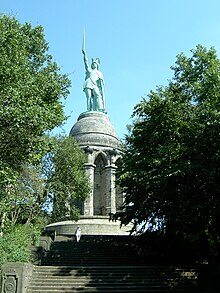This is an old revision of this page, as edited by 195.40.200.222 (talk) at 22:19, 19 June 2005. The present address (URL) is a permanent link to this revision, which may differ significantly from the current revision.
Revision as of 22:19, 19 June 2005 by 195.40.200.222 (talk)(diff) ← Previous revision | Latest revision (diff) | Newer revision → (diff)
The Hermannsdenkmal (German for Hermann monument) is located in North Rhine Westphalia in Germany in the Southern part of the Teutoburg Forest, southwest of Detmold in the district of Lippe. It stands on the densely forested and 386 m tall Teutberg in the ring fortification located there, which is called Grotenburg. The sword has the following inscription:
Deutschlands Einigkeit meine Stärke - meine Stärke Deutschlands Macht. Translation: Germany's Unity my Strength - my Strength Germany's Might.
The monument commemorates the Cherusci war chief Arminius and the Battle of the Teutoburg Forest in which germanic tribes under Arminius recorded a decisive victory in year 9 over three Roman legions under Varus.
History
Construction for the 53.46 m tall statue was started in 1838, but not completed until 1875 with the help of substantial funds from the state of Prussia. It was built according to plans constructed by the sculptor Ernst von Bandel.
The genesis of the sculpture has to be understood in the context of the German political situation in the 19th century. Under the impression of the repeated defeats at the hands of the French and the fractured nature of the German states, Germans began to orient themselves toward the ancient past as a source of national pride. This search for identity is exemplified in several national memorials including the Valhalla near Regensburg and the Statue of Arminius.
However, the statue was not completed until after the Franco-Prussian War of 1870-1871, and the unification of most of Germany in 1871 under Bismarck, so it also has to be understood as a symbol of the young Germany emerging at the time.
Tourism
The statue is one of the most popular tourist destinations in Germany with over two million visitors a year. Of similar popularity are the Externsteine, which are located nearby.
A similar statue of Herman the German exists in New Ulm, Minnesota, a town settled by German immigrants.